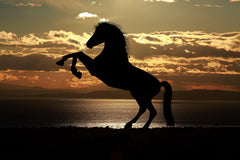Chinese Swords - The Dao
3 minute read
A Wicked Blade for a Foreign Horseman

Mahmut Sabri was a member of the Tang dynasty's cavalry corps. Recruited because of his height, skill with a horse, and ability to accurately use a weapon while riding at high speeds, his job was to go into battle ahead of the main army and soften up the enemy. As were many of the cavalry, he was Uighur, not Han Chinese. This was because the Han were not as skilled with horses, but recognized the strong force multiplier cavalry were to any army, so they bolstered their ranks with foreigners.
While his horse was his own, he had recently been given a Chinese blade. Chinese swordsmithing was second to none in the region, and this sword - called a Dao, was easy to use, especially for cavalry. Sharp on one side and slightly curved, it was a mean blade, made to cut into infantry and lay waste. Mahmut looked forward to using it in the coming battle.
Featured Sword: Dao
Chinese swords are divided into two types: the Jian and the Dao. They were both considered one of the Five Weapons - along with the spear, halberd, and staff.
Dao swords are single-edged and usually curved. They were created as swordsmithing advanced, and it was discovered that dulling one of the sides of the Jian and thickening it would increase its reliability. As Japanese swordsmiths received much of their early swordsmithing knowledge from China, some people say that the Dao influenced the Japanese toward making their renowned Katana and Wakizashi. Because of its relative ease of use compared to the Jian, the Dao quickly became a favorite in battle, and the Jian fell out of favor except by officials and experts.
Laying Waste
Mahmut rode into battle, skillfully jumping over small creeks, avoiding caltrops, and cutting into the infantry around him. A few tried to stab at him with spears, but they either missed or struck the light armor on the horse. He laughed and swung his Dao, the sharp edge easily cutting through his target, the reinforced spine absorbing the shock, then springing back into shape, ready for the next cut. The reliability and ease of use of the Dao amazed him, and he smiled again as he neared his next target.
Fun Facts
Even though Dao swords are single-edged, they will sometimes have a few centimeters of the spine sharpened to aid in thrusts. Also, they are considered much easier to learn - it was once said “it takes a week to learn a dao, a month to learn a qiang (spear), and a year to learn a jian!”
Etymology
Dao (traditional & simplified: 刀, 1st tone) is a Chinese word that originally meant “knife”, though it later expanded to include the meaning of “knife money” (a type of old currency) and, more recently, the “US dollar.”
Further Reading
If you liked this post and would like to learn about the Dao's sister sword, please check out post Chinese Swords - The Jian.
If you are interested in learning more about the history of both sword types, as well as Chinese swordsmithing in general, please check out our post Chinese Swordsmithing - A Rediscovered Treasure.

